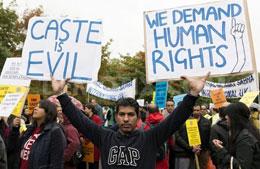Ontario declares caste is discriminatory

By Shilpashree Jagannathan
New Canadian Media
The Ontario Human Rights Commission (OHRC) has become the first in North America to officially incorporate caste as a discriminatory policy.
The provincial regulatory authority that advocates for equality and combats discrimination published the updated code on Oct. 26.
“Discriminatory treatment based on xenophobia, that is, dislike of or prejudice against people from other countries, is also contrary to the Code,” said the OHRC statement. So is discrimination based on a stereotype or perception that an individual or group practices a religion or comes from a community associated with the caste system.”
Many jurisdictions in Ontario and Canada have already passed a motion to add caste as a discriminatory category. Toronto District School Board, approved a motion to address casteism on March 8. Toronto was the first Canadian jurisdiction to create a formal mechanism to acknowledge and address caste issues.
Burnaby, B.C. and Brampton, Ont. have added caste as a protected category in their city policies. All these motions had referred it to their provincial human rights commissions to create further policy guidelines.
“It is a landmark position,” said Vasanthi Venkatesh, associate professor of law, land, and local economies at the University of Windsor.
“The Ontario Human Rights Commission, historically, has always been at the forefront of pushing the definitions of discrimination to include all sorts of marginalization. It (the position) also says that it’s intersectional. So that means that caste is not just captured singularly by race or singularly by descent or similarly by ancestry, it is all these grounds together and it’s complex.”
Vijay Puli, founder of the South Asian Dalit Adivasi Network, said the OHRC position will have a direct impact on the school board motion and Brampton. The Toronto-based activist organization has been at the forefront of anti-caste activities in Ontario.
“As a parent, this is the best protection gift I can give to my children and future generations here,” Puli said.
Said Yalini Rajakulasingam, the Toronto District School Board trustee who introduced the caste motion: “I look forward to all continuing to advocate for caste equity and building more inclusive spaces where we celebrate and empower all identities.”
Hindu groups nationwide have long resisted caste motions. They cite a lack of caste data, concerns about linking casteism to Hinduism, and believe current laws already address the caste system.
The OHRC statement cites caste-based oppression as an internationally recognized violation of human rights and that it is a global problem.
“A United Nations report states that discrimination based on caste and similar systems of inherited status is a global problem.”
The caste system is an ancient, rigid South Asian hierarchical system that separates people into different social groups based on birth. A person’s caste can be identified by their last name, family background, food habits, occupation or racial profile. People who are considered to be in lower castes have historically been relegated to menial jobs and have a lesser social status.
Among South Asians, there are four different caste hierarchies: Brahmins, Kshatriyas, Vaishyas, and Shudras. Those outside of these castes were formerly treated as untouchables and called Dalits. This discriminatory practice is banned in India but continues in many parts of the country.









